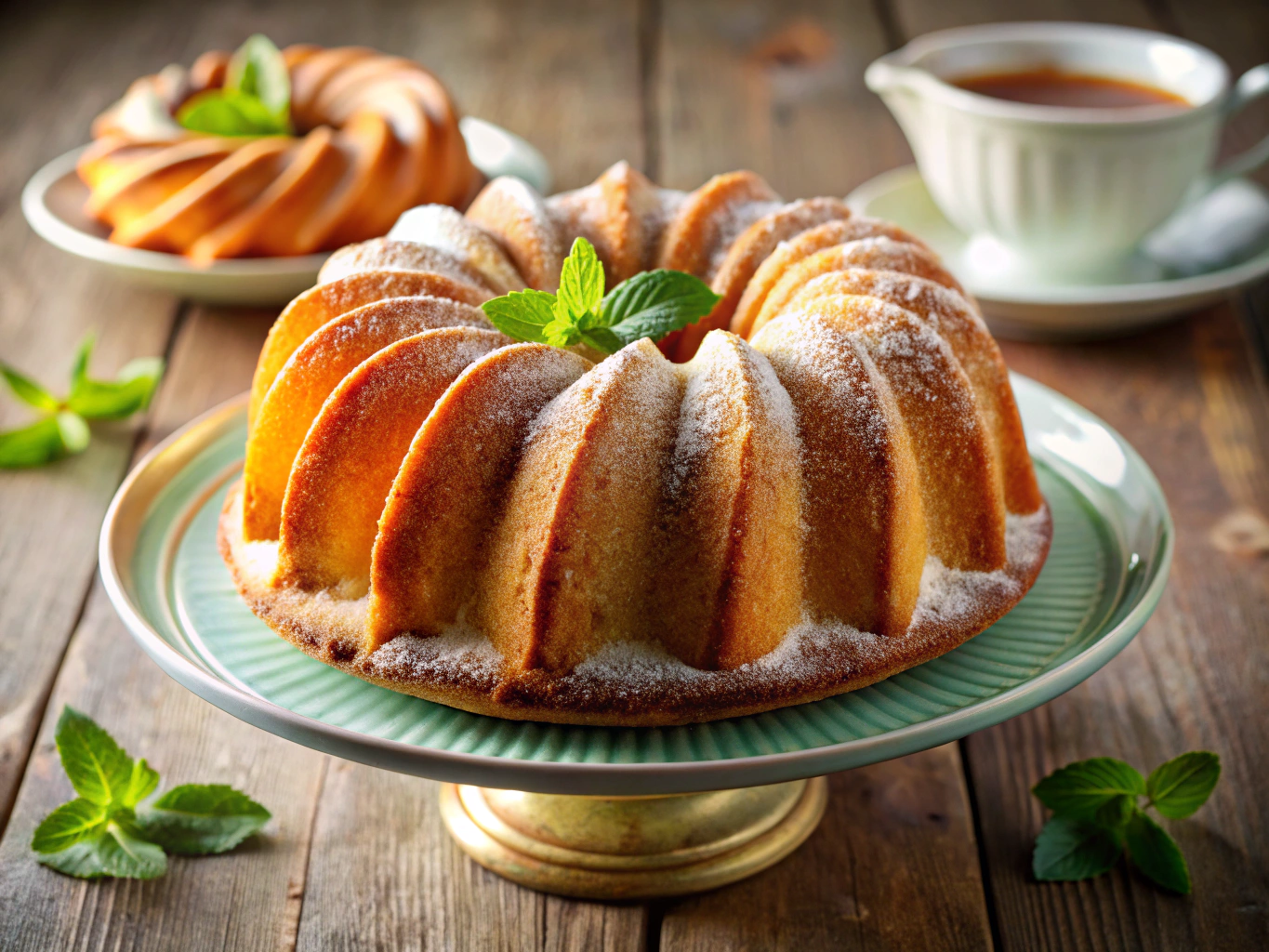
If there’s one dessert that blends heritage, flavor, and wow factor, it’s the irresistible Bundt cake. In this article, we’ll explore why this cake stands out, how it came to be, and how to craft the perfect version in your own kitchen. Expect personal stories steeped in sweet, cinnamon-swirled history, crowd-pleasing techniques, and tips to outshine boxed-cake expectations. You’ll also discover how this humble dessert made history and finds a place in famous households. So grab your whisks, and let’s unravel the delicious charm of a Bundt cake together.
Bundt Cake Memories & My Southern Twist on Tradition
From Grandma’s Charleston Kitchen to Modern Reimagination
My very first Bundt cake memory? I was six, perched high on a wooden stool in my grandma’s Charleston kitchen. Flour floated through the air like dust motes in the Carolina sun. Her Bundt pan was battered but trusted. She never needed a recipe—just scent, instinct, and emotion. That cinnamon-vanilla scent convinced me love could be baked.
I’m MacMar, 42-year-old Charleston native and flavor explorer. I learned comfort food from my grandmother and added bold twists in farmers’ markets, food trucks, and late-night cookfests. Bundt cake quickly became my canvas for creativity. There’s something magical about the ridges the pan creates—each one a golden opportunity to soak in the glaze or hold soft ribbons of filling.
People often ask if Bundt cake is just a regular cake in a fancy mold. But here’s the truth—it’s more than shape. It’s how heat flows around the curves, creating slightly crisp edges and moist, tender centers. That pan design creates texture contrast you just can’t get from a standard round tin. That’s one reason I often add lush centers—whether it’s lemon cream or apple cider-infused pecans.
What Makes a Bundt Cake Different?
It starts with the shape, sure, but the magic runs deeper. The Bundt cake pan’s design allows even baking, better structure, and easy decorating with powdered sugar or drizzled glazes.
Unlike standard round or square cakes, Bundt cakes often include denser batters designed to hold their shape. This difference is key when choosing a recipe—too airy and the cake might tear when flipped. I’ve learned this the hard way during one ill-fated experiment involving matcha, coconut cream, and a stuck pan that landed frosting-side-down.
That’s why I created a foundational citrusy almond Bundt cake recipe. It blends tradition and twist, balancing moisture, flavor, and visual impact. Garnish it with toasted flakes and you’ve got the showstopper your brunch table’s been craving.
Ingredients, Baking Tips, and Instructions for a Stellar Bundt Cake
Gather Your Ingredients & Have Fun with Substitutions
You don’t have to go fancy to create a knock-out Bundt cake. Most ingredients are pantry staples, and many can be swapped to suit your taste or what you have on hand.
| Ingredient | Notes/Substitutions |
|---|---|
| 2½ cups all-purpose flour | Can use gluten-free 1:1 flour blend |
| 1 tsp baking soda | Ensures lift and texture |
| ½ tsp salt | Enhances sweetness |
| 1 cup unsalted butter, softened | Use vegan butter or coconut oil for plant-based option |
| 1¾ cups sugar | Light brown sugar adds depth |
| 3 eggs | Use flax eggs for a vegan version |
| 1 tbsp vanilla extract | Adds warmth and aroma |
| 1 cup sour cream or Greek yogurt | Can be swapped for non-dairy yogurt |
Time Breakdown: From Mixing Bowl to Cake Stand
Bundt cakes don’t require complicated steps, but they do ask for patience. Moisture matters, and cooling time is crucial to avoid sticky disasters when unmolding.
- Prep Time: 15 mins
- Bake Time: 50–60 mins
- Cooling Time: 20–30 mins
- Total Time: ~90 mins
That’s around 20% quicker than some layer cakes, which need frosting, stacking, and constant adjustments. You’ll spend less time fussing and more time wowing guests. According to ChooseMyPlate.gov, choosing desserts you can control ingredient-wise can also support balanced eating strategies.
Step-by-Step Instructions for Bundt Cake Brilliance
- Preheat oven to 350°F. Grease your Bundt pan thoroughly—every nook matters.
- Whisk flour, baking soda, and salt in a medium bowl. Set aside.
- In a stand mixer or with a hand mixer, beat butter and sugar until light and fluffy, about 3-5 minutes.
- Add eggs one at a time, beating well after each. Stir in vanilla.
- Add the dry ingredients alternately with sour cream. Begin and end with dry for even texture.
- Spoon batter into pan and tap lightly to release bubbles.
- Bake for 50–60 minutes until the top springs back or a skewer comes out clean.
- Cool 20 minutes, then flip carefully. Wait another 10 minutes if it resists.
- Glaze or dust to taste.
Add your personal touch with toppings from this easy vegan glaze or sprinkle crushed nuts over powdered sugar for texture.
Beyond Shape: The Cultural Charm & Celeb Favorite
Why Is It Called a Bundt Cake?
The word “Bundt” stems from the German word “bund”—meaning a gathering or group. Its ring shape symbolized unity and communal baking occasions. The iconic pan shape was actually popularized in 1950s America by Nordic Ware and gained legendary status after a Texas woman won a Pillsbury bake-off with a tunnel-of-fudge cake.
From my perspective, Bundt cakes feel like community baked into form—lush in flavor, formed to serve, meant for togetherness. They’ve made appearances at my holiday spice spreads and Mother’s Day lemon cakes, each time playing the role of centerpiece and conversation starter.
Famous Fans: Kamala Harris & the Bundt Cake Love
Interestingly, Vice President Kamala Harris is a fan of Bundt cakes—particularly ones with warm spice, according to several interviews. That warmth reflects culture, family, and comfort. Whether it’s pumpkin-spiced or classic rum glazed, the shape brings a grounded familiarity.
I’ve shared many versions at potlucks, crafting recipes inspired by friends’ heritage—from spiced Persian Bundts to my neighbor’s Mexican chocolate twist. The flexibility of the Bundt format makes it a globe-hugging cake pan ready for any flavor passport.
Serving, Storage & Make-Ahead Bundt Cake Tips
Best Ways to Present and Store
Bundt cakes shine solo or dressed up. A few quick tips:
- Serve at room temp or slightly warm for maximum flavor.
- Dust with powdered sugar for simplicity.
- Or drizzle a glaze and decorate with zest, nuts, or berries for added pop.
For care:
- Store covered at room temp for 3 days.
- Refrigerate for up to a week.
- Freeze (unfrosted) for up to 2 months, tightly wrapped.
Make-Ahead and Batch Options
To me, a good Bundt cake is like conversation—it flows best without pressure. That’s why I love prepping it a day ahead. The flavors deepen overnight. You can even freeze cooled slices individually for future sweet moments.
If baking for a crowd, use two medium Bundt pans and halve bake time. Kids love minis baked in silicone ones—just reduce temperatures slightly and watch like a hawk.
Once you nail the ratio, almost everything else is optional. Want bold citrus? Add zest. Got cardamom? Elevate that vanilla base. Need a nutty lift? Swirl in almond paste. The beauty lies in the bund.
FAQs
How is Bundt cake different from regular cake?
Bundt cakes are baked in shaped pans that allow better heat circulation and a distinct look. They often use denser batter to hold that shape and emphasize moisture and crust contrast.
What is Kamala Harris’ favorite cake?
Vice President Harris enjoys spice-forward flavors such as pumpkin or cinnamon—styles that adapt beautifully into the Bundt cake format.
Why is it called a Bundt cake?
The name “Bundt” is derived from the German word “bund,” meaning a gathering. Its ring shape encouraged communal celebration and easy slicing.
What does bundt mean in German?
“Bundt” loosely stems from “bund,” which refers to group or bond. It historically symbolized unity through shared meals.
Conclusion
Bundt cake isn’t just cake—it’s memory molded, heritage baked, and tradition reimagined. From nostalgic Southern Sunday gatherings to punchy, zest-filled celebrations, it adapts to every baker’s story. Whether it’s your first time flipping one out of a pan or your fiftieth, the reward is always the same: joy on a fork. I hope this guide inspires you to experiment with flavors and shapes that speak to your heart. And remember—if the smoke alarm goes off, you’re probably doing something delicious.
